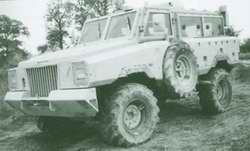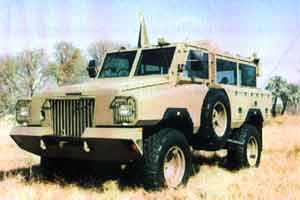| Designation: | Mamba Mk2 |
 |
|---|---|---|
| Manufacturer: | Denel Vehicle Systems - DVS | |
| Product type: | Armoured Vehicles | |
| Name: | Armoured car |
The original Mamba 4 × 2 vehicle was developed by Mechem Consultants, part of the Denel Group, and a number of production vehicles was built.
Further development by Reumech OMC resulted in the Mamba Mk 2 (4 × 4), which is some 70 mm higher than the earlier two-wheel drive version.
Between 1993 and 1997 a total of 653 Mamba vehicles was manufactured for the home and export markets with production ranging from three vehicles a week up to four vehicles a day.
The first contract was awarded early in 1993 and covered the supply of three prototypes and 151 production vehicles, with all vehicles being completed by March 1994.
By the time production was completed late in 1997 a total of 67 Mambas had been exported to seven different countries. Nine Mamba variants had been developed for specific clients requirements and marketing.
Reumech OMC was subsequently taken over by Vickers Defence Systems of the UK and renamed Vickers OMC. Late in 2002, Alvis PLC purchased Vickers Defence Systems and Vickers OMC was renamed Alvis OMC. Late in 2004 Alvis Plc was taken over by BAE Systems and Alvis OMC became BAE Systems Land Systems OMC.
Early in 2003 it was stated that some of the South African National Defence Force Mambas had been upgraded.
In the longer term, the remaining Casspir and Mamba (4 × 4) vehicles in service with the South African Army will be replaced by a new generation of vehicles, which will share some common components. A new fleet of 4 × 4 and 6 × 6 tactical trucks is expected to be fielded in the future, to replace the current SAMIL range of tactical trucks.
With the downsizing of the South African Army, significant quantities of Mamba vehicles have become surplus to requirements. Description
The monocoque V-shaped hull of the Mamba Mk 2 is of all-welded steel armour construction that provides a very high degree of protection against anti-tank mines as well as small arms fire and shell splinters.
The standard Mamba Mk 2 steel hull and glass provides protection against 5.56 × 34 mm and 7.62 × 51 mm NATO ball small arms ammunition with an optional protection against 7.62 × 51 mm NATO armour-piercing ammunition.
The driveline and suspension of the Mamba Mk 2 is from the well-known German Mercedes-Benz UNIMOG 416 (4 × 4) range of cross-country vehicles, which is in service with civil and military users all over the world. This gives the Mamba exceptional cross-country mobility. More recent vehicles have improved Mercedes-Benz axles and road wheels. This gave the vehicle improved payload and cross-country mobility.
According to the manufacturer, the Mamba protection level includes a single anti-tank land mine under any wheel station, a centre anti-tank land mine, small arms fire up to 7.62 mm rifle, shell splinters or incendiary and limpet mine.
The layout is conventional, with the Mercedes-Benz diesel engine at the front, commander (left) and driver (right) and troop compartment at the rear. Normal means of entry and exit is through a large door in the rear that is hinged on the left.
Nine troops are carried, five seated on the left side and four on the right side facing each other on individual seats with a full harness seat belt. Above the commander's and driver's position is a roof hatch that opens to the rear and can be locked in the vertical position, with additional roof hatches being provided in the rear troop compartment. These are located three either side, are hinged on the outside and can be locked in the vertical position.
Stowage lockers are located on the exterior of the hull and mounted at the rear is a tow hitch with seven-pin electrical connector. A replacement wheel and tyre is located on the left-hand side of the hull just to the rear of the front road wheels.
Bulletproof windows are provided for the front, sides and rear of the Mamba Mk 2 and these provide the same level of protection as the steel hull. If required, these windows can be provided with integral firing ports.
Drive is taken from the diesel engine to the four-speed full synchromesh gearbox with the high and low ranges giving a total of eight forward and four reverse gears.
The pneumatically controlled differential locks operate front and rear separately. Two- or four-wheel drive may be selected while the vehicle is in motion.
The front and rear axles are fitted with coil springs and hydraulic dampers. The air-assisted foot-operated duplex braking system acts on discs all-round. A cable-operated parking brake and an exhaust brake are also provided.
Standard equipment includes a 100 litre water tank and optional equipment included air conditioning system, a roof-mounted light machine gun mount, firing ports, run flat inserts, higher level of armour protection, various communications equipment, customised internal layout, electric 5-tonne winch mounted at the front of the vehicle and various seating arrangements. Variants
The design of the Mamba Mk 2 (4 × 4) vehicle is such that it can undertake a wide range of roles in addition to its basic role as an armoured personnel carrier.
Projected roles included ambulance, command post, utility vehicle, recovery vehicle, VIP transport and logistic support. If required, lower levels of protection against small arms fire and land mines can be provided.
A short wheelbase version has been developed called the Komanche, which can carry up to seven people. There is also a platform version called the Sabre, which has a four-man fully enclosed cab at the front and a platform at the rear on which can be mounted a variety of weapons and other systems, or it can be used as a cargo carrier. Left-hand drive models of the Mamba Mk 2 are also available.
BAE Systems Land Systems OMC has undertaken the conversion of a large number of South African Army Mamba Mk 2s to the latest Mk 3 configuration. Improvements include:
- Improved ride and stability
- Additional ballistic protection
- Improved braking
- Smaller armoured windows
- The removal of side bins and relocation of the external fuel tank to a position where it is now under armour protection
In the late 1990s, the then Alvis Vehicles carried out further development work on the Mamba which resulted in the Alvis 4 and Alvis 8 series of mine protected vehicles.
A small quantity of these vehicles were sold by Alvis Vickers to the British Army for use by Royal Engineer Explosive Ordnance Disposal (EOD) teams working in the Balkans, but these have now been replaced by another vehicle called Tempest. In 2004 the UK supplied seven of these vehicles to Estonia for use in Afghanistan.
|
||||||||||||||||||||||||||||||||||||||||||||||
|
|||||||||
|
||||||||||||||||||||||||||||||||||||||||||
Related Articles |
|
Iconic Armoured Mamba Hulls to be made by MTL Group (18.08.2012) |
|
BAE Systems gets R900m MRAP upgrade deal (01.02.2011) |
|
BAE Systems Launches New Variant of South Africa’s Most Successful Export Mine Protected Vehicle (20.09.2008) |
 |
 |
 |
 |
 |
 |











